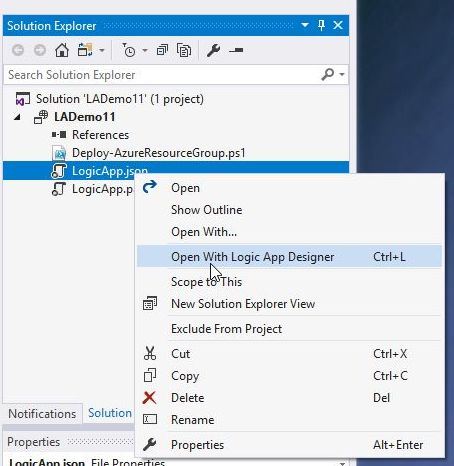Hello!
Among all the characteristics that has Logic Apps, there is one that is worth emphasizing
We can use Visual Studio 2017 to create, edit and publish Logic apps type applicationsLogic Apps
There is an excellent tutorial in the official documentation (see references), although there are a couple of things that need to be clarified to have the whole environment working.
If you have installed Visual Studio 2017 and the Cloud Workload, you will surely be able to follow the following steps
Create a project of type [Cloud//Azure Resource Group]

Select [Logic App] from the Visual Studio templates

At this time we will be able to see the main files for the definition of a Logic App: LogicApp.json and LogicApp.parameters.json. We can edit both, and see the content in text mode

However, we do not have the option [Open with Logic App Designer], which is the one that allows us to use the Visual editor to define our process

Well, this step is not well explained in the official documentation. After validating that my Azure SDK and other tools are up-to-date, I realized that you need to install a specific extension for Visual Studio 2017: Azure Logic Apps Tools for Visual Studio 2017
Once installed, we can edit our logic Apps with the logic App Designer

After configuring the credentials we will use in Azure, we can see that in fact the integration of the Designer is a webcontrol where we navigate the same webview that uses the portal.


That if we can use all features that gives us Visual Studio 2017, and integrate with Git, TFS or other Source Control provider, deploy from the IDE and much more.
Happy Coding!
Greetings @ Toronto
El Bruno
References
Logic Apps
- Design, build, and deploy Azure Logic Apps in Visual Studio
- Marketplace, Azure Logic Apps Tools for Visual Studio 2017
My posts on Logic Apps
- Let’s create our first Logic App in Azure
- Logic Apps, Introduction and main differences with Microsoft Flow
My posts on Flow
- Check your Apps health in Azure using Application Insights and Microsoft Flow
How To iterate through collections of elements (Excel, Sharepoint, Cognitive Services and more…)Trigger a Flow associated to an item in a #SharePoint list - New input options when using Flow Button: list of choices
- Working with Expressions
- Export and Import Flow definitions with advanced options
- How To emulate a Button for a Flow using a Browser
- Advanced options to work with an HTTP Action in Microsoft Flow, Headers, Authentication and more
- Working with Variables in Microsoft Flow
- Handle exceptions, errors, timeouts and more in a Microsoft Flow definition
- Buttons Widgets in iOS and Android
- New action definition to use Computer Vision APIs from Microsoft Cognitive Services
- Schedule a Flow execution, recurrence supported!
- “Save as ” and interaction with physical buttons FLIC and BTTN
- Email Sentiment Analysis on a PowerBI dashboard, and Flow
- Support for Team coauthoring and sharing
- Calling a Flow from a C# ConsoleApp
- Push Notification Support
- How to review a Flow process
- How to invoke a Flow from an external app using HTTP Request